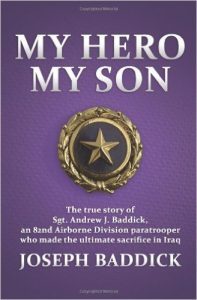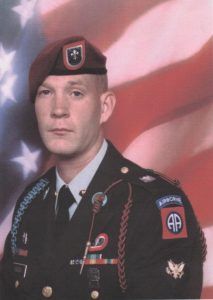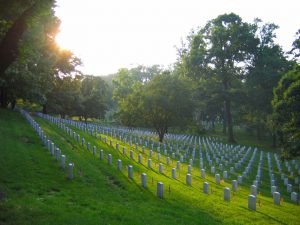My Hero, My Son
The Baltimore Post-Examiner is proud to present excepts from My Hero, My Son by Joseph Baddick. My Hero, My Son is a celebration of the life of Sgt. Andrew J. Baddick, an 82nd Airbore Division paratrooper who sacrificed himself to save a fellow soldier in Iraq. Narrated by his father Joseph, the account begins with A.J.’s birth, recalls his youth in the Pennsylvania coal region, and continues through his life-defining military service. Through anecdotes, personal letters and interviews, we witness an adventurous teen’s transition into a soldier and an American Hero. My Hero, My Son is available at Amazon and Barnes and Noble.
Bad News
It was October 1, 2003. My wife, Sheila and I were sleeping soundly when the telephone awoke us at approximately one o’clock in the morning. I was about to receive the phone call every parent dreads. It was my daughter, Elizabeth, and from the sound of her voice I could tell something was wrong. “Dad”, she said, “A.J. is dead.” My voice trembling, I said, “what?” “He’s dead. A.J. is dead.” Even though I knew this was my daughter speaking to me, something in the back of my mind was telling me this could not be true.

A voice I did not recognize now spoke to me. “Mr. Baddick, I am the chaplain assigned as liaison in this matter and it appears there was an accident involving your son Andrew and he drowned.” I told him, “that can’t be, my son is an excellent swimmer.” I told the chaplain there had to be a mistake, were they absolutely sure it was A.J. who died in the incident. My mind went blank and I dropped to the floor crying, sitting against the bed, a lost soul in a lost world. Everything came to a screeching halt, like you sometimes see in the movies, where time stands still. I just sat there and sat there, oblivious to what was going on around me. Finally, after what seemed like forever, Sheila came over and said that she had finished speaking with the chaplain and he explained that the next day a sergeant assigned as our Casualty Affairs Liaison would be coming to the house to meet us. Sheila held me for a long time as I cried. She would be my life support for the coming days and weeks.
Sergeant First Class Kulikowski came to our house the following day and introduced himself as our liaison. He said he traveled from Tobyhanna Army Depot, north of us which is quite a drive. He explained to us that anything we needed or wanted information about, he was the person to go to. My first question for the sergeant was how long would it take to get our son’s body back from Iraq. He told me there would first be an in depth investigation as to the cause of his death. He was right about that, it took nearly a week until A.J.’s body was flown back to the states. SFC Kulikowski also broke the news to us that A.J.’s funeral would be closed casket. I asked why, since the cause of his death was drowning, but the sergeant could not answer that question for us.
A.J.’s body arrived at Dover Air Force Base in Delaware and was now in the hands of mortuary officers there. We could make arraignments to have A.J.’s body released to our own funeral director. I made a call to the E. Franklin Griffiths funeral home in Tamaqua. I spoke to the director, “Sanky” who was a personal friend of our family. My father and his were very good friends back in the day. When Sank’s father passed away, he inherited his father’s funeral business. Sanky had buried my father the previous year in January of 2002. He would bury my son in October 2003 and my mother in January 2004. Within a three year period, I would lay to rest three family members I loved dearly. Sanky came to the house and we discussed funeral arraignments for A.J. My daughter Elizabeth reminded me of what A.J. had said if anything happened to him. I remembered him telling me that he wanted to buried in Arlington but I was considering having him interred at Fort Indiantown Gap National Cemetery since it was much closer for us to visit. The rest of the family insisted I respect A.J.’s wishes and have is burial at Arlington National Cemetery. I finally decided that if A.J. wanted to be laid to rest there, then I had to follow with it or I would regret it later on. Sanky said he take care of arrangements with Arlington, and much to our despair we found out that A.J. could not be buried there for a month because they were so backed up with funerals. The following day, Sanky called and said he received a phone call from a woman at Arlington who told him they would be able to accommodate us and have A.J. buried within the next few days. We were so relieved.

Word of A.J.’s death spread quickly through the Jim Thorpe area, where he worked as a guide for Jim Thorpe River Adventures during high school and after graduation. Then-owner Dave Kuhn had met A.J. when he was twelve and took him on his first trip on the Lehigh River. Two years later, Kuhn said A.J. was a proficient kayaker. Kuhn said A.J., who called him “Uncle Dave”, worked on and off for thirteen years. He said he had an easygoing personality and was well-liked by customers whom he guided down the river. Flags were flown at half-mast at the Jim Thorpe area schools, at the Carbon County courthouse, and the Dolan-Jones-Martino American Legion Post 304, on the east side of Jim Thorpe, not too far form A.J.’s home…
Arlington
I awoke the morning of October 14, 2003 and thought, “Today we lay our son to rest in Arlington, Virginia.” It seemed as if it was a bad dream. Parents are not supposed to bury their children. We’re supposed to grow old and die and they bury us. How could I be in such a convoluted situation? That Tuesday was not a particularly nice day weather-wise. I remember it being cold and damp. As Sheila and I began getting ready for yet another difficult day in our lives, my mind started drifting to happier days with my son. It was just too hard to believe it was over. All the stress and depression of the last few days had taken its toll on me, my body decided to remind me just how low my resistance had become. As I began to put on my underwear, I threw my back out. I could hardly straighten up or move. I though, “This is just great. How am I going to manage to get through this day?” Sheila said she would call my cousin, Dr. Peter Baddick, and see what he thought. We had contracted a bus to take our family and friends to Arlington and Pete would be on the bus. He told Sheila he would bring the necessary medication I would need to get me through the day. I finally managed to get dressed, with Sheila’s help, and we went to the funeral home. We got on the bus and Dr. Pete was there waiting to medicate me. All I remember him saying was, “take this, and this, and this, and this.” I must admit, when we arrived at Arlington, I felt much better. With the aid of a cane I was moving around pretty good.
I started reminiscing about the time I brought A.J. and Elizabeth to Washington for a visit. I remember we did a lot of walking and I showed them the Washington Monument, and we went to the Smithsonian Museum of Natural History. Then we went over to Arlington and I know A.J. was impressed. However, on the ride home, I asked him what he enjoyed the most, and his answer was, “the pigeons.”
We arrived at Arlington early and some of our friends wanted to see the Tomb of the Unknown Soldier. I made the long walk up the hill and we were in time to see the changing of the guard ceremony. My godchild, Chelsea Mizenko, was really excited to be able to view the entire procedure. We went to President John F. Kennedy’s gravesite and then back down the hill to the Administration Building. Outside there were eight paratroopers from the 82nd Airborne Division, and by the flash on their berets I could see they were members of Headquarters and Headquarters Company. I went over and introduced myself and Sheila to them. I told them our son was being buried there that day. The man in charge, First Sergeant Miller, told us they knew, they were there for A.J. He explained that they had served with A.J. in Afghanistan. I shook each soldier’s hand and thanked them for being there….
* * * * *
Just what is Arlington National Cemetery? Best known of the more than one hundred national cemeteries in the United States, Arlington’s green slopes shelter veterans from every war that has involved our nation. Over 275,000 service men and women, and their family members rest on the 624 acres of Virginia land. Approximately twenty four burials are conducted every weekday.

All who are remembered there have this in common: service to their country. To each one, no matter what rank or station, whether decorated hero or unknown, belongs a place of honor.
When Civil War casualties overflowed hospitals and burial grounds near Washington, D.C., Quartermaster General Montgomery Meigs proposed in 1864 that two hundred acres of the Robert E. Lee family property at Arlington be taken for a cemetery. “The grounds around the mansion,” Meigs wrote, “are admirably adapted to such a use.”
The cemetery is open year round, 365 days, for visitation. The 3rd U.S. Infantry, traditionally known as “The Old Guard” is the Army’s official ceremonial unit and escort to the president. It is the oldest active duty unit in the Army, serving our nation since 1784.
A funeral with full military honors is a dignified and moving experience. An honor guard accompanies the American flag-draped coffin. Muffled drums beat the slow cadence as the coffin is carried to the gravesite. Before the remains are lowered, a squad fires three rifle volleys and a bugler blows the long notes of “Taps.” Finally, the flag is folded and presented to the next of kin.
Many prominent figures are buried in Arlington: President John F. Kennedy, Glenn Miller, Audie Murphy (WWII Medal of Honor recipient), Joe Louis (world heavyweight boxing champ and WWII veteran), Pierre Charles L’Enfant (designed of the capital city), Admiral Richard Byrd (polar explorer and Medal of Honor recipient), Oliver Wendell Holmes (Civil War veteran and Supreme Court Justice), Lt. General Cliare Chennault (organized the All Volunteer Group, The Flying Tigers), General of the Armies, John J. Pershing (WWI), and sailors from the USS Maine at Havana harbor.
Sentinels of the 3rd U.S. Infantry maintain an around the clock vigil at the Tomb of the Unknowns. A sentinel paces 21 steps down the mat before the tomb, pauses 21 seconds, and returns. The changing of the guard takes place every hour (or half-hour from April through September). Entombed here are the remains of unknown servicemen from World War I, World War II, Korea, and Vietnam. “Here rests in honored glory an American soldier known but to God” reads the inscription on the sarcophagus of the World War I soldier entombed there in 1921.
Symbols of the human struggle and sacrifice, the stones and monuments of Arlington National Cemetery are steeped in history. In their time, all who are buried there – taken from many walks of life, creeds, and races – answered their country’s call. Their stories will forever be remembered.
Inscribed inside the apse of the Memorial Amphitheater are these words, taken from a letter, written June 26, 1775, by then General George Washington, to the Provincial Congress. “When we assumed the soldier, we did not lay aside the citizen.” Inscribed above the stage, from Abraham Lincoln’s Gettysburg Address, it reads, “We here highly resolve that these dead shall not have died in vain.”

Joseph Baddick served as an 82nd Airborne Division paratrooper before working for the Pennsylvania Department of Corrections for twenty years. Originally from the coal region, he now resides with his wife Sheila in Berks County, PA. He enjoys golf, winemaking, fine dining, traveling, the outdoors. and spending time with his grandchildren. Baddick is also the author of the book All American Hearts: True Stories of America’s Wounded Warriors.
